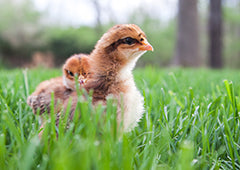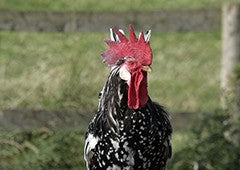“Peep, peep! Cheap, cheap!” Welcome to the wonderfully egg-citing world of fuzzy little baby chicks! Falling in love at first sight may be just a cliché or something that only happens in the movies, until you take your first peak at your new baby chicks. When you hold their feather light fuzzy little bodies in your hands for the first time, you feel as if you’re holding the world in your hands, because time stands still! Nothing else seems to matter at the moment, but the miracle of new life peeping away in your hands. So, go ahead, and get clucky for baby chicks! Sing, and shout, and do the chicken dance - celebrate the beauty and splendour that is the wonderful world of baby chicks!

The very first step in caring for your newly hatched baby chicks is to ready their brooder before they’ve hatched, you’ve picked them up, or they’ve arrived via post. A brooder can be as simple as a large cardboard box or plastic tub/container, or you can purchase a commercial chick brooder. Most importantly, you want to be assured that everything is in working order well before you need. So, several days prior to hatching/arrival, set up the brooder, clip on the heat lamp and plug it in. Be sure to locate the heat lamp on the side of the brooder and not directly over the centre, so as to offer your chicks an easy egg-scape if they become too warm. Set a thermometer inside and after a while, check to see that the temperature has risen to 32-35 degrees Celsius. If so, turn off the lamp and repeat “I will be patient” as often as necessary, until hatch day. On the morning of hatch day, set up your brooder with bedding, feed, water, thermostat and plug in the lamp. Feed chicks a commercial Chick Starter, which is available as medicated or non-medicated up until 8 weeks of age.
One word of warning though, if you had your chicks vaccinated against Coccidiosis, feed them un-medicated starter because the medicated starter will cancel out the vaccine. Bedding for chicks can be as simple as paper towel, shredded newspaper, or our favourite, hemp bedding, but whatever type you choose, make sure to replace the bedding as often as necessary. A clean brooder = happier, healthier chicks! Then, bring on the fluffs!
At the end of this article, if you feel you would like more in-depth step-by-step details, check out our friends at Chickenpedia. They specialise in online courses for raising chickens and offer a great selection of downloads and check-list that make chicken keeping a breeze, I highly recommend them.
Settling your new chicks into their brooder home may elicit a tear or two but this is just the beginning of an egg-straordinary journey! Before you set each chick down into the brooder, gently dip their beaks into the drinker and watch them swallow as you place them in the brooder. Water is vital to chickens from the wee ones to the old mother hens! They should naturally find their way to the feeder. If not, gently scatter some chick starter onto the bedding near their feeder and that should get the ball rolling!
Now let’s talk about brooder basics. As mentioned above, beginning brooder temperature should be approximately 35 degrees Celsius. Reduce this about 5 degrees each week as your young ones grow and mature. And, do they ever! Treasure every single moment with these little ones, because in the mere blink of an eye, fuzzy becomes feathery and soon they’ll be anxious to fly from the motherly brooder to the coop and egg-slpore the great outdoors! Anyway, back to the basics. Pay close attention to how your chicks behave. If they're all crowded together directly under the heat source, they're cold. Lower the heat lamp or add another one. If they're around the edges of the brooder, avoiding the heat and each other like the plague, they're too hot! Raise the heat lamp. A happy flock will happily be exploring all around the brooder. You’ll easily know if the brooder is much too warm or too cold!

Simply watching the everyday goings on inside the brooder, is GREAT FUN and will keep you abreast of your babies’ comfort level. So, what does a typical chick look like and how does it behave? For the first day or two, baby chicks are much like human newborns - they sleep, eat, and peep and poop! Sleepy chicks are often quite hilarious as they can fall asleep in the blink of an eye, literally-they just flop down wherever they are and they’re asleep. They can even fall asleep, wait for it…standing up, although they do look a bit a wobbly! You may even spy a bit of feather popping out here and there, depending on the breed, as some breeds do mature more quickly than others. Hold on to your hat though, because these quiet sleepy days are over! Growing chicks are busy, busy, busy! They are egg-straordinary multi-taskers! They can peep, poop, flap, and run all at the same time! Simply amazing, isn’t it? These curious babies want to egg-splore, egg-splore, egg-splore!
Well, now that we know what a typical healthy chick looks like and how it behaves, what are some signs and symptoms that we should be on the lookout for in a not so healthy baby chick? Well, since healthy chicks are busy chicks, chicks that are feeling under the weather will most likely not be busy. Signs of an ill chick are inactivity, watery eyes, watery poop(more than usual) and not eating or drinking. Chickens’ respiratory systems are quite sensitive; therefore it is essential to keep their brooder as clean as possible. Soiled bedding is a breeding ground for illness, as chicks tend to peck at their own poop.
A common malady that effects young chicks is called “Pasting Up”. Pasting up occurs when a chick’s droppings stick to it’s fuzzy little chick vent. If you notice this, simply apply a moist warm cloth or paper towel to the chick’s bottom and wipe gently. If left untreated, it can cause more serious complications as the poor baby cannot pass droppings. So, keep a watchful eye on your flock and they should develop normally and grow like CrAzY!
Gently handling your chicks will help them to get accustomed to human touch. Some will be more apt to interact with you than others, and that’s perfectly normal. Encourage the shy ones with feed from your hand, or offer them treats such as cooked rice and pasta, dry oats and bread, and of course greens. Chickens are very, very, very motivated by food! So, be patient and they’re sure to come around. An egg-cellent way to encourage socialization is to host a family sleepover with the chicks! If your brooder is set up in a spare room, wonderful, camp out right there. However, if not, just move the brooder temporarily to the family room, sunroom, or playroom and let the FUN begin! Eat some egg-straordinary egg dishes, hold your chicks, brainstorm names for the new feathery family members, quietly whistle to them…they’ll literally stop whatever they’re doing, yes they’ll even cease peeping to listen, read chicken keeping books and quiz each other, cuddle with your chicks, make up chicken riddles, talk to your chicks, do a chicken find-a-word, sing to your chicks, create your own original *Chicken Memory Game (the cluckier and wackier the better !) and play, and mostly just love, love, love those sweet little baby chicks! If you’re not afraid of a little poop, then let them out of the brooder to wander around and get their “coop legs” so to speak, and they will inevitably climb all over you and your family! The point is to savor these first few days and weeks with your fuzzy chicks, because they practically “fly” by.
At three weeks old your young flock is ready for, wait for it…roosting practice! Yay! This is just such fun to watch! You can easily make a homemade roost by drilling a hole in each of two wooden blocks and inserting a dowel so that the roost is approximately 5cm off the brooder floor. Voila…it’s time for roosting practice! Your chicks will be cautious at first, yet intrigued by this newfangled piece of furniture that just appeared out of nowhere inside their cozy abode. They will peck at it egg-cessively, but eventually, curiosity will get the better of them and they’ll hop on up. Be prepared though, because chances are these young trainees will topple over peeping all the way. You can help them to get back on again by gently setting them above the mini-roost until their little feet grip. When your chicks outgrow this roost, you can replace it with a higher one. Here’s to happy training sessions!

Next, on your young flock’s agenda, are field trips to the field, of course. These first outings are also such fun. Actually, everything about chicks is egg-citing and fun! On a lovely warm sunny day, transport the brooder outside for a little taste of egg-straordinary adventures yet to come! Let them out into the fresh grass and sit back and watch your egg-static little ones leap and flap, peep and poop, run and chase and just have the grandest time living as nature intended. The can run fast! So be sure to stay close, or put them in an area where they can’t escape through a fence. When they’ve had enough of the good life and may be literally “pooped out”, as if that could ever happen, take your egg-hausted little ones back inside for some much needed naps.
So, your fuzzy little babies are literally growing by leaps and bounds! Wonderful! It is absolutely egg-straordinary how quickly these young ones do grow. Ah, but alas, these sweet babies are now maturing young pullets, feathers have replaced most of the fluff, they’ve grown quite tall and gawky, and they’re well on their way to becoming lovely young hens. Growth and development zip along at a fast pace from day two or three on up to about three months of age as your chicks undergo their biggest transformation from baby to young chook. So, you may want to keep your camera at the ready so you can snap photographs of this once in a lifetime egg-uberant egg-stravaganza- not that you will stop here! Oh, no…chicken addiction is a rapidly spreading condition and is Oh So Contagious! Anyway, it’s always enjoyable to be able to look back on our past chick egg-speriences and reminisce about the journey you had with your family as you watched the chicks grow! As your young chooks continue to grow and mature some telltale signs that they are doing so will be the changes in their combs and wattles- these will grow larger and become a brighter red color. Young roosters-to-be may even begin to crow about their egg-speriences at around 12-16 weeks of age!
Eventually, it will be moving day! At about 6 – 8 weeks of age, your fully feathered friends will be ready to move to their outdoor coop and let nature continue the course you so lovingly began. So, what began just a couple short, short months ago, will always continue in your heart!!! Have an egg-straordinarily flap-happy journey!
Are you looking to raise baby chicks? Or have you already started your journey? Tell me about your experiences in the comments below, I would love to hear from you.
We all know just how quickly these little ones grow up so you are going to want to make sure that you've got the knowledge you need to raise a happy, healthy flock. 67% of chicken keepers surveyed experienced a chicken health or behaviour issue in the first 12 months that they didn’t know how to handle. I recommend that you click here to check out our friends at Chickenpedia. They will be able to give you the knowledge and confidence you need to raise healthy chickens.
“Living with animals can be a wonderful experience, especially if we choose to learn the valuable lessons animals teach through their natural enthusiasm, grace, resourcefulness, affection and forgiveness.” – Richard H. Pitcairn.


















